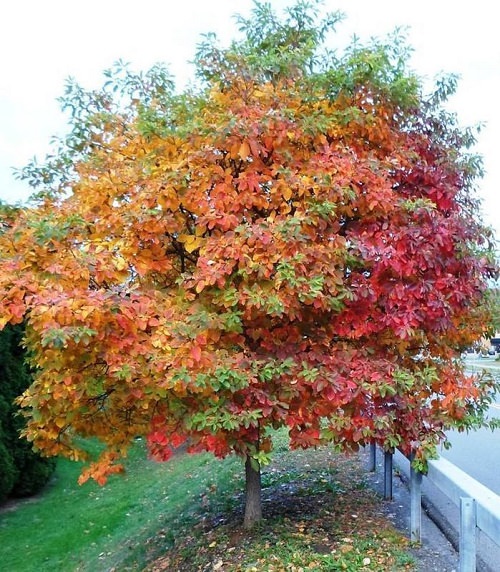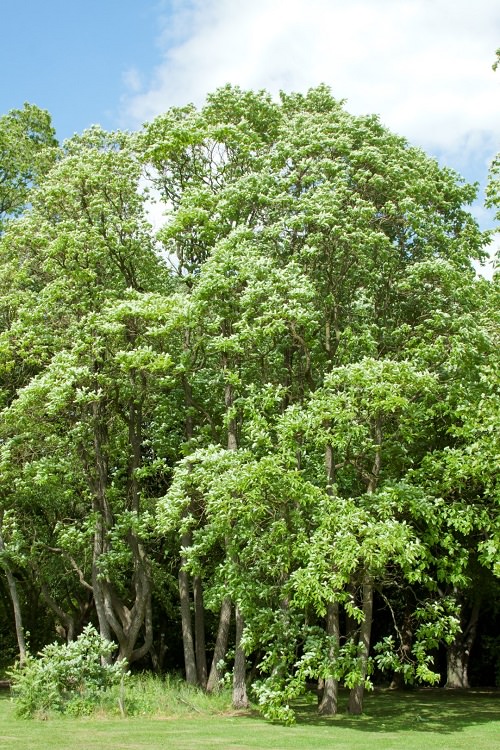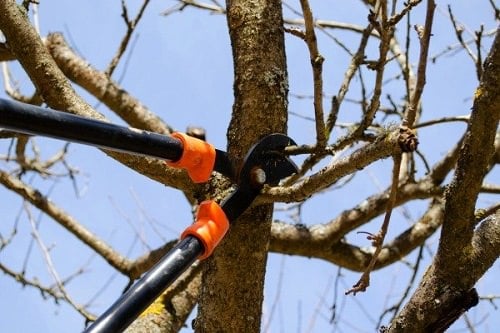If you have enough space in the garden, then Growing Sassafras Tree makes perfect sense! Let’s know everything about this traditional American tree.
Growing Sassafras Tree is easy and this way, you can introduce a tall specimen in your front garden that’s also going to provide you some privacy too!
USDA Zones: 5 to 9
Other Names: Ague Tree, Bois de Cannelle, Cinnamon Wood, Common Sassafras, Kuntze Saloop, Laurier des Iroquois, Laurus albida, Saloop, Sasafras, Sassafrax, Sassafras albidum, Sassafras officinale, Sassafras variifolium, Saxifrax.
Here’s everything you need to know about growing Moringa tree
About Sassafras Tree
Sassafras tree is mildly fragrant and one of the most beautiful trees for landscaping. It is native to North America and can grow up to 40-80 feet tall. All parts of the tree are aromatic, and the leaves release a citrus-like smell when crushed. Its yellow flowers bloom in summer and smell like root beer. The foliage takes a stunning orange-red hue in autumn.
All parts of the sassafras tree are useful and used for culinary and medicinal purposes. Its leaves and flowers are used in salads and to flavor many other dishes.
Growing Sassafras Tree
You can grow the tree from seeds but it will take a lot of time, so it’s better that you purchase a well-grown specimen from a nursery. Transplant it to a location where the tree can get a lot of direct sunlight. Sassafras tree grows well in dry and sandy soil. Mature trees can grow wide and large so grow them at least 15 to 20 feet away from buildings or other large objects.
Sassafras Tree Facts
Sassafras trees are known to repel mosquitoes and other insects. The rich flavor from sassafras roots has also been put in soups and stews for an unusual extra flavor. It also attracts wildlife too.
Note: Root bark of sassafras contains safrole, which is carcinogenic, and is harmful for human consumption.
Check out some amazing Sassafras Tree Facts here
Pruning Sassafras
Regular light pruning prevents the development of suckers, which appear around the base, and the tree grows tall and looks more ornamental. If you prefer to have it with a single trunk, cut off the suckers just below the surface of the soil. You can also leave the suckers in place for a more shrubby and dense shape.
There are male and female flowers on separate sassafras trees and only female ones produce fruits after flowering. These fruits are loved by birds!
Pests and Diseases
Scales, Japanese beetles, weevils, and moths can affect it but the damage is minimal and you do not need any steps to control these pests.
Fungal diseases such as leaf spot can also affect sassafras trees but rarely requires treatment. Verticillium wilt is another fungal disease, that infects the tree, making the branches wilt and die. A healthy mature tree can usually recover from the damage, but there is no real cure for the disease. Still, you can prune infected branches completely to avoid them from spreading further.





Help!! My neighbor’s sassafras tree took over our backyard and I need help in controlling it. We are going through and cutting unwanted shoots just under the ground, but with almost a quarter acre affected, we’re losing the war! I don’t want to use Roundup because of a resident box turtle and toads.. Any tips?
Hi Karin,
My suggestions:
– Trim in areas you don’t want it;
– Let them grow in a spot that you won’t mind; and
– Try planting other larger trees/plants that will shade out the small sassafras shoots when they come up.
Probably doesn’t sound like a good answer, but on the flip side, it seems you’re super lucky! Resident box turtle and toads? Cool!!
I am actually going to plant sassafras in my yard because not only does it provide amazing orange/red fall colour and fruit that feeds lots of wildlife (birds & mammals including foxes), it’s the host plant of the spicebush swallowtail butterfly (https://en.wikipedia.org/wiki/Sassafras_albidum). So if you cat beat’em, use ’em:)
Hi Karen. Trim all unwanted hanging plant and pile it in an outdoor area where you want your own garden to flourish.the decaying plant matter will add nutrients to your soil and help the plants your want to grow get bigger and better. You can also shred and grind the material or start a composter.
Thank you for this most informative article. I’m new to growing Sassafras so this comes in very handy.